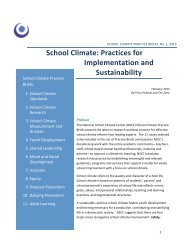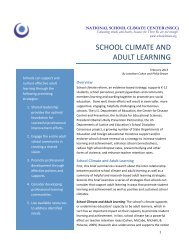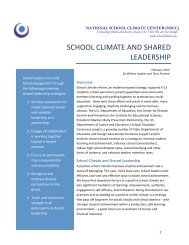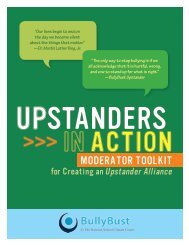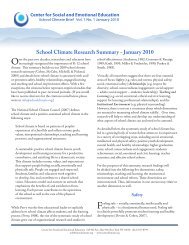Download PDF - National School Climate Center
Download PDF - National School Climate Center
Download PDF - National School Climate Center
Create successful ePaper yourself
Turn your PDF publications into a flip-book with our unique Google optimized e-Paper software.
attitudes and perceptions (Ransford, Greenberg, Domitrovich, Small& Jacobson, L. ,2009). Once interventions are instituted<br />
that support teachers’ efforts and leadership, there will be a positive revitalization of school climate settings (Rhodes,<br />
Camic, Milburn, & Lowe, 2009).<br />
7. Several commentators noted that it would have been useful to emphasize even more than we did that positive<br />
school climate is associated with and predictive of academic achievement. Indeed, there is a growing body of scientific<br />
data offering objective assessments of neighborhood environment and students’ self-reported school and neighborhood<br />
safety. These assessments are strongly associated with (both positive and negative) academic performance (Milam, Furr-<br />
Holden, & Leaf, P, 2010). More and more evidence demonstrates that sustained and significant attention to the “whole<br />
child” will result in academic gains.<br />
8. There needs to be a more deliberate link between the SC Standards and a growing national movement entitled<br />
“Response to Intervention”. As Jo Ann Freiberg suggests, if the <strong>School</strong> <strong>Climate</strong> Standards could be (eventually) aligned<br />
with RTI, there would be more likelihood that states, districts and individual schools would embrace adoption and implementation.<br />
9. Two commentaries (Jo Ann Freiberg and John Eller) also criticized the Council’s decision to use the terms “school<br />
climate” and “culture” (as well as supportive learning environments and conditions for learning) interchangeably. In fact,<br />
this was an early debate within the Council when we developed the consensual definition of school climate and a sustainable<br />
and positive school climate. Various authors have and do define all of these terms in a variety of ways. The Council<br />
suggests that the consensually developed definition integrates these different points of view. Also, we suggest that what is<br />
most important – whatever term we use – is that we are very specific about the measurable dimensions. Although Einstein<br />
wisely suggested “not everything that can be counted counts, and not everything that counts can be counted” in K-12 education<br />
“what is measured is what counts”.<br />
Our commentators also made valuable suggestions about next steps. We have been urged to consider:<br />
• an action-planning matrix to guide and support plans for implementation (Carter).<br />
• ongoing work that needs to be done in the areas of teacher-education, professional development and teacher training<br />
(Preble & Gordon).<br />
• a comprehensive web site that includes best practices and tools (protocols and rubrics) to support effective SC<br />
improvement efforts<br />
• a more explicit connection between the tenets of character education and school climate (Santiago & Ferrara). As<br />
these are overlapping fields of knowledge, it will support practitioners and policy makers to be clear about the similarities<br />
and differences.<br />
• a network of “sites of excellence” (Santiago & Ferrara). (We might note that the Character Education Partnership<br />
has worked on just this endeavor for years: recognizing <strong>National</strong> <strong>School</strong>s of Character- www.character.org/nsoc)<br />
• even more specific measurement strategies that allow practitioners to assess the more detailed indicators and sub<br />
indictors that ‘flesh out’ each of the five standards. (Eller)<br />
• vigilant efforts to assure that our practices and systems reflect a deep respect of cultural sensitivity, equity for all<br />
constituents, and an asset-based approach that celebrates and embraces diversity. (Ross & A’Vant).<br />
We appreciate these recommendations. Presently, we are building a web-based <strong>School</strong> <strong>Climate</strong> Resource <strong>Center</strong> that addresses<br />
virtually all of the suggestions that have been made here. This powerful tool will be a tremendous resource serving<br />
as a guide to best practices, a clearinghouse for new ideas, a forum for the sharing of ideas, a compendium of the latest<br />
research and a center for both teacher and student led activities that are both practical and user-friendly.<br />
At the same time we are implementing <strong>National</strong> <strong>School</strong> <strong>Climate</strong> <strong>Center</strong> strategies and resources in several states and<br />
schools to better understand the realities of school climate efforts, continuously improve our strategies and resources, and<br />
develop enhanced products for our many constituents.<br />
Whenever there is opportunity to advance truly transformational work, there is also the tendency to “speed it up” and at-<br />
_____________________________________________________________________________<br />
<strong>National</strong> <strong>School</strong> <strong>Climate</strong> <strong>Center</strong><br />
Educating Minds and Hearts,... because the 3 Rs Are Not Enough<br />
545 8th Ave., Rm 930, New York, NY 10018 (212) 707-8799 info@schoolclimate.org - www.schoolclimate.org<br />
35



